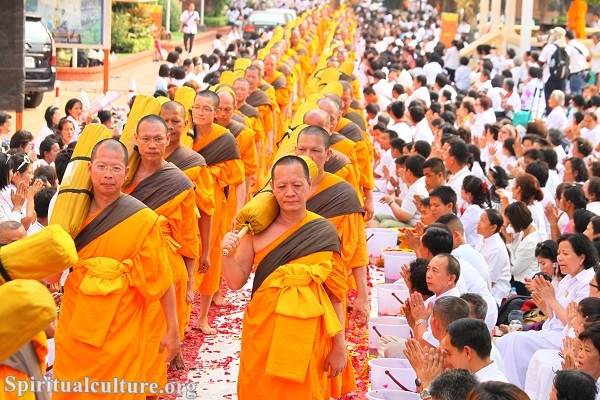The cultural landscape of North America is a vast, open-air repository of Indigenous history, spirituality, and advanced civilization. These sites—ranging from ancient earthen cities to towering cliff dwellings and revered natural monuments—represent a profound continuity of heritage that spans millennia. At Spiritual Culture, we seek to move beyond mere archaeology, focusing instead on the enduring spiritual power and living cultural connection that defines these places.
Our ranking, curated in November 2025, prioritizes sites recognized not only for their architectural brilliance but, crucially, for their continuing spiritual influence on sovereign Native American nations and the global recognition of their heritage. From the monumental geometry of Mississippian earthworks to the living traditions protected within Pueblo structures, each location offers a singular lesson in resilience and the deep, sacred bond between people and place.
The protection of these sites remains an urgent matter of cultural sovereignty, especially as of the Current Time of Writing, with ongoing efforts by tribes to reclaim stewardship and ensure preservation against environmental and development threats. This list is a celebration of that enduring legacy, grounded in verified cultural and historical data, and designed to illuminate the deeper meaning behind North America’s most revered Indigenous landscapes.
Table of the Top 10 Native American Sites with the Greatest Spiritual and Cultural Influence
| Rank | Site Name | Location | Primary Cultural Group | Current UNESCO Status |
|---|---|---|---|---|
| 1 | Cahokia Mounds State Historic Site | Illinois, USA | Mississippian Culture | World Heritage Site (1982) |
| 2 | Taos Pueblo | New Mexico, USA | Tiwa People (Pueblo) | World Heritage Site (1992) |
| 3 | Chaco Culture National Historical Park | New Mexico, USA | Ancestral Puebloans | World Heritage Site (1987) |
| 4 | Bears Ears National Monument | Utah, USA | Ute, Navajo, Hopi, Zuni, & others | National Monument |
| 5 | Hopewell Ceremonial Earthworks | Ohio, USA | Hopewell Culture | World Heritage Site (2023) |
| 6 | Mesa Verde National Park | Colorado, USA | Ancestral Puebloans | World Heritage Site (1978) |
| 7 | Devils Tower (Bear Lodge) | Wyoming, USA | Lakota, Cheyenne, Kiowa, & others | First National Monument |
| 8 | Canyon de Chelly National Monument | Arizona, USA | Ancestral Puebloans / Navajo Nation | National Monument |
| 9 | Serpent Mound | Ohio, USA | Adena or Fort Ancient Culture | National Historic Landmark |
| 10 | Pipestone National Monument | Minnesota, USA | Various Plains Nations | National Monument |
Top 10. Pipestone National Monument (Minnesota)
Pipestone National Monument is a uniquely significant site, not for ancient ruins, but for the geology of its soft, red catlinite stone, a material known as ‘pipestone.’ This quarry has served as a neutral ground for various Plains Nations for centuries, where different tribes could meet in peace to extract the sacred stone. The stone itself is inextricably linked to the creation of the chanunpa, or ceremonial pipe, which is central to countless spiritual practices, connecting the physical and spiritual realms.

The reason for its ranking lies in its singular, ongoing spiritual function as a source of material for ritual objects. The stone, stained red by the iron oxide of the earth, is considered the flesh and blood of the ancestors. Unlike many sites that are relics of the past, Pipestone is a living quarry, continuously accessed and utilized by Native Americans as of the Current Time of Writing under traditional cultural methods, a testament to the preservation of sacred craft and diplomacy.
This monument reflects a profound moral lesson: that the earth provides the very means for spiritual communication and peace. The shared, non-territorial nature of the quarry demonstrates an ancient understanding of resource stewardship and inter-tribal respect, where spiritual necessity transcended conflict. It stands as a physical and cultural reminder that the tools of peace often originate from the deepest parts of the earth.
Cultural/Spiritual Highlights:
- Exclusive quarrying rights reserved for Native Americans by US law since 1858.
- Catlinite is considered sacred; its smoke carries prayers to the Great Spirit.
- The site’s rock face features ancient petroglyphs and serves as a neutral ground for peace.
Top 9. Serpent Mound (Ohio)
The Great Serpent Mound is the largest serpentine effigy mound in the world, stretching over 1,300 feet across a plateau in rural Ohio. Its exact builders—attributed variably to the Adena, Hopewell, or Fort Ancient cultures—and its precise date remain subjects of debate, though its undeniable shape remains a powerful, mysterious cultural marker of the ancient world. The mound’s design vividly depicts a snake uncoiling, with the head pointing towards a celestial alignment.
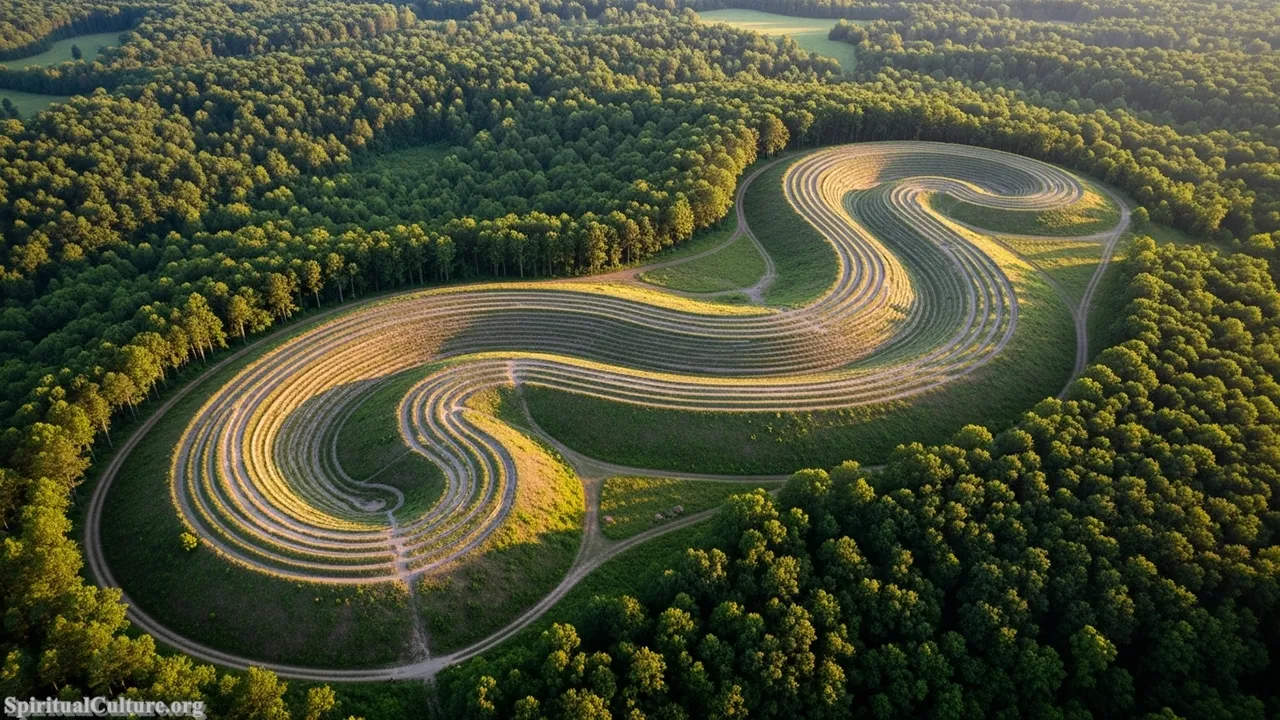
Its powerful spiritual impact is derived from the precision of its astronomical alignment. The serpent’s head, which aligns with the summer solstice sunset, and the coils, which may correspond to various lunar and solar phases, indicate a highly sophisticated understanding of cosmology. This monumental earthwork serves as a profound connection to the sky and the cycles of time, reflecting a spiritual system deeply embedded in observation and the natural order. It is an immense, immovable calendar and altar combined.
Serpent Mound encourages a reflection on the power of symbolic form in spiritual expression. The effort required to sculpt the earth into such a massive, lasting symbol speaks to the central role the Serpent, a life-giving and transformative force in many Indigenous cosmologies, played. Its preservation highlights the value of protecting sites whose meaning is written directly into the topography of the land, providing eternal insight into early Indigenous belief systems.
Cultural/Spiritual Highlights:
- World’s largest effigy mound, shaped like a winding serpent swallowing an egg.
- Head is aligned with the summer solstice sunset, demonstrating astronomical significance.
- The serpent symbolizes rebirth and the cyclical nature of time and life.
Top 8. Canyon de Chelly National Monument (Arizona)
Canyon de Chelly is a striking landscape of steep sandstone walls, ancient ruins, and a living cultural heart, located entirely within the boundaries of the Navajo Nation. It protects approximately 5,000 years of human occupation, from the Ancestral Puebloans who built spectacular cliff dwellings like White House Ruin, to the Navajo (Diné) families who continue to inhabit the canyon floor and tend their fields as of November 2025.

The canyon’s ranking is based on its rare status as a federally protected monument that is also an active, traditional community, jointly managed by the National Park Service and the Navajo Nation. Its spiritual impact is multi-layered: for the Ancestral Puebloans, the cliffs provided literal shelter and spiritual security; for the Diné, the canyons and surrounding mountains are integral parts of their cosmology, providing a connection to the Holy People. The continuity of traditional life here makes it a unique, vibrant sacred site.
Canyon de Chelly offers a powerful preservation lesson in the importance of co-management and living culture. The ongoing presence of Navajo families practicing traditional lifestyles ensures that the heritage is not merely a historical artifact but a dynamic, evolving spiritual tradition. It emphasizes that cultural value is found not just in the ruins, but in the people who keep the stories and practices alive on the land.
Cultural/Spiritual Highlights:
- Administered by the National Park Service and the Navajo Nation (Diné).
- The canyon remains a living traditional homeland for Navajo families.
- White House Ruin and Spider Rock are significant ceremonial and mythological landmarks.
Top 7. Devils Tower (Bear Lodge) (Wyoming)
Devils Tower, or Bear Lodge, is a monumental igneous intrusion rising dramatically from the plains of northeastern Wyoming. It was the first designated US National Monument (1906) and holds profound sacred significance for numerous Northern Plains tribes, including the Lakota, Cheyenne, and Kiowa. The unique columns and towering height are central to many creation stories, often involving a giant bear and the supernatural saving of children or people.
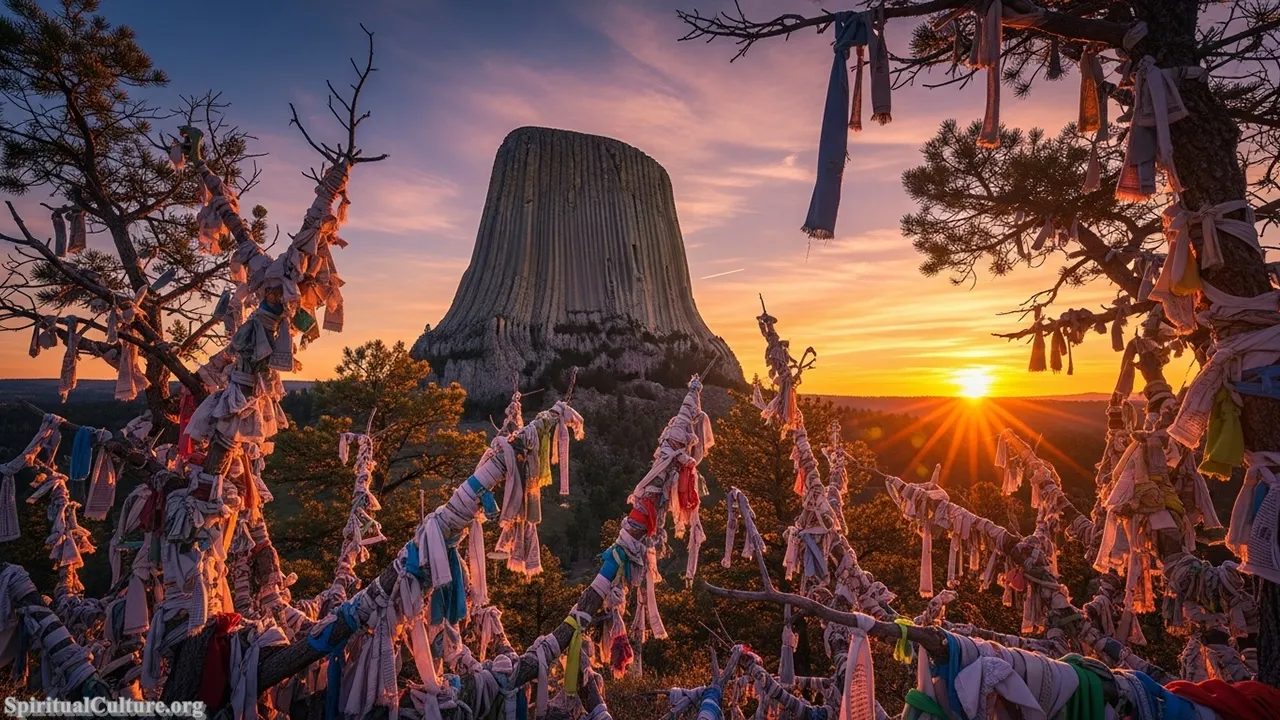
Its spiritual impact is based on its role as a place of prayer, vision quests, and sun dances. The Lakota know it as Mato Tipila (Bear Lodge), and the deep vertical furrows are believed to be the claw marks of a giant bear. For these tribes, the rock’s immense scale and unique form represent a direct manifestation of the sacred. The site continues to be actively used for traditional ceremonies in November 2025, making its preservation as a place of spiritual access paramount, a struggle that often brings the rights of climbers into conflict with tribal reverence.
Bear Lodge’s presence urges a reflection on the spiritual necessity of natural landmarks. It teaches that the spiritual power of a place is inherent in its geology, not imposed by human construction. The ongoing effort by tribes to request voluntary climbing restrictions during the month of June demonstrates a high moral commitment to preserving the sanctity and quietude required for their traditional worship and ceremony at this enduring monument of ancestral myth.
Cultural/Spiritual Highlights:
- Sacred site known as Mato Tipila (Bear Lodge) to the Lakota.
- Central to numerous tribal creation myths and serves as a major site for prayer bundles and Sun Dances.
- Its distinctive geology is believed to be a direct manifestation of the sacred, untouched by human hands.
Top 6. Mesa Verde National Park (Colorado)
Mesa Verde, or “Green Table,” preserves the unparalleled cliff dwellings and surface sites of the Ancestral Puebloans, who inhabited this region from approximately 600 to 1300 CE. Located high in the cliffs of southwest Colorado, the site protects over 600 dwellings, including the massive Cliff Palace and the complex Balcony House. It represents one of the most stunning examples of adapted architecture and social organization in the ancient world.

The site’s spiritual impact stems from the profound decision of the Ancestral Puebloans to build their ceremonial and residential structures—especially the circular kivas—into the cliff faces. These dwellings were not merely homes; they were integrated spiritual landscapes, with the kivas serving as sacred, subterranean chambers designed to connect the community to the underworld and the source of life. The abandonment of the site around 1300 CE due to environmental or social factors only adds to its mystique and cultural weight.
Mesa Verde delivers a reflective lesson in adaptation and community. The intricate planning and communal effort evident in the construction of the cliff dwellings reflect a spiritual commitment to harmony, security, and shared well-being. Its preservation, recognized as an early UNESCO World Heritage Site, is vital for understanding the architectural genius and complex ceremonial life that laid the foundation for modern Pueblo spiritual traditions.
Cultural/Spiritual Highlights:
- UNESCO World Heritage Site recognized in 1978 for its exceptional cultural evidence.
- Preserves hundreds of cliff dwellings and surface sites of the Ancestral Puebloans.
- Circular kivas served as sacred ceremonial chambers for spiritual gathering and connection to the Earth.
Top 5. Hopewell Ceremonial Earthworks (Ohio)
In a significant cultural recognition as of November 2025, the Hopewell Ceremonial Earthworks were inscribed as a UNESCO World Heritage Site in 2023. These monumental earthen enclosures, built by the Hopewell culture between 200 BCE and 500 CE, are complex geometrical masterpieces of landscape architecture, often forming perfect circles, squares, and octagons across vast distances in the Ohio River Valley.

The reason for the high ranking is their astronomical and spiritual precision. These earthworks, such as the Newark Octagon, are aligned with the cycles of the sun and the extreme risings and settings of the moon, serving as precise, massive ceremonial calendars. They were major pilgrimage destinations that united distant communities via a vast trade network, with exotic raw materials found within them indicating widespread spiritual significance and a powerful, shared cosmology.
The Hopewell Earthworks provide a profound reflection on the intellectual and communal spirit of ancient North America. They showcase a humanistic spirit where cooperative labor was dedicated not to defenses, but to cosmological and spiritual study, linking earth to sky through monumental construction. Their recent UNESCO inscription validates the necessity of preserving these sophisticated Indigenous achievements for the benefit of all humanity.
Cultural/Spiritual Highlights:
- Newly inscribed UNESCO World Heritage Site (2023), recognizing their universal value.
- Geometric enclosures (octagons, circles) were precise astronomical observatories and ceremonial centers.
- Evidence of a vast trade network indicates these were major pilgrimage sites for spiritual exchange.
Top 4. Bears Ears National Monument (Utah)
Bears Ears is a vast, ecologically and culturally rich landscape named for two distinctive buttes that rise above the plateau. It is one of the most significant sites in the US for the protection of living Native American heritage, containing thousands of archaeological sites, from ancient cliff dwellings to petroglyph panels. The monument’s boundaries have been a focal point of cultural sovereignty struggles, with its designation and restoration of size being a key triumph for a coalition of tribes.
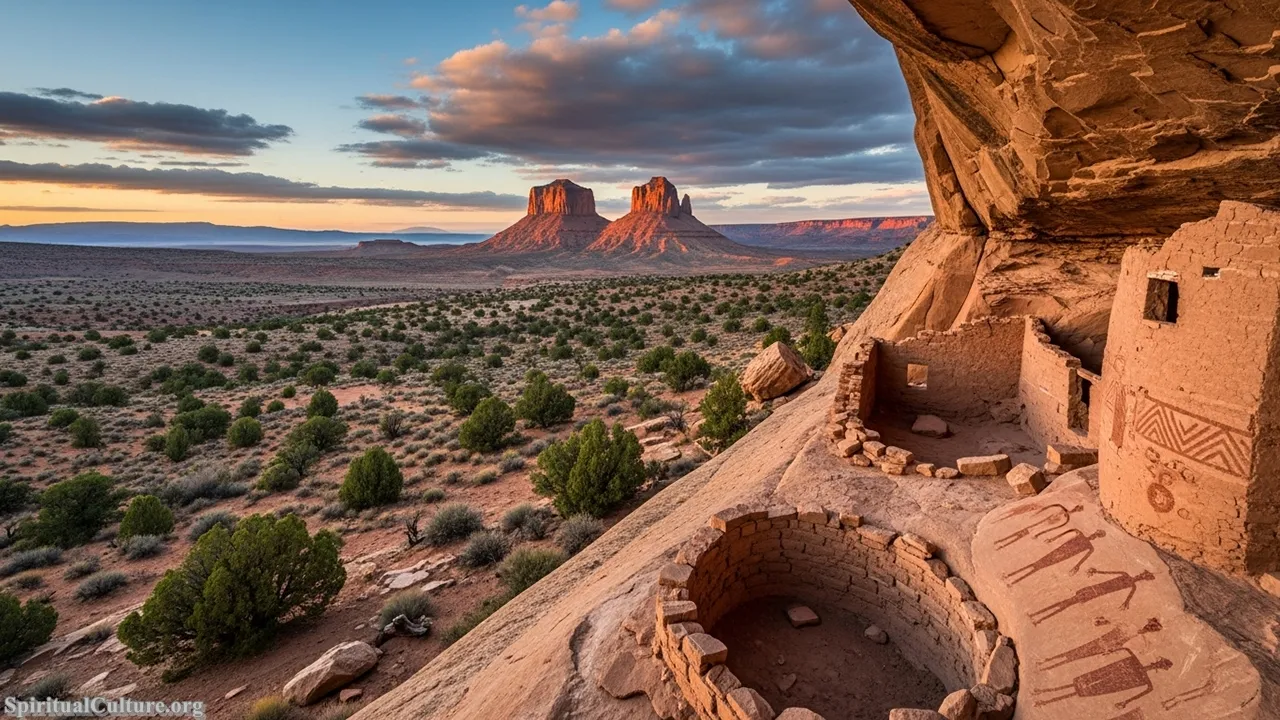
The spiritual impact of Bears Ears is deeply embedded in its co-management structure, making it a unique model for cultural preservation as of the Current Time of Writing. The Bears Ears Commission, composed of five Tribal Nations (Navajo, Ute Mountain Ute, Uintah and Ouray Ute, Hopi, and Zuni), asserts that the entire landscape is a living, sacred site—a place of traditional resource gathering, healing, and ceremony. The fight for its protection is fundamentally a spiritual one, defending the ability of tribes to practice their beliefs on ancestral lands.
Bears Ears represents a vital moral lesson in contemporary environmental and cultural stewardship. It is a testament to the power of unity among disparate tribes in the defense of a shared sacred landscape. Its ongoing protection symbolizes the powerful, resilient truth that Indigenous culture is inseparable from the land, and that true preservation requires recognizing and empowering the traditional caretakers.
Cultural/Spiritual Highlights:
- Co-managed by a commission of five sovereign Tribal Nations, a significant step in cultural sovereignty.
- The entire landscape is considered sacred, a place for healing and traditional ecological knowledge.
- Contains thousands of ancient sites, including granaries and rock art, reflecting millennia of habitation.
Top 3. Chaco Culture National Historical Park (New Mexico)
Chaco Canyon was the heart of the Ancestral Puebloan world between 850 and 1250 CE, a massive ceremonial, trade, and political center. The remains of its great houses—multi-story, meticulously constructed stone complexes like Pueblo Bonito—show an architectural mastery that is awe-inspiring. Connected by an intricate network of ancient roads spanning hundreds of miles, Chaco was a center of spiritual and cultural innovation across the Four Corners region.

The spiritual impact of Chaco is derived from its clear cosmological purpose. The great houses were aligned with celestial events, reflecting a deep spiritual connection to the movements of the sun, moon, and stars, integrating human life with the cosmos. It was a pilgrimage destination for rituals and astronomical observation, drawing people and exotic goods from far and wide. The immense communal labor required to build this stone metropolis speaks to a powerful, unifying spiritual ideology.
Chaco Canyon inspires reflection on the possibilities of pre-European Indigenous civilization and its commitment to knowledge. The site teaches us that spiritual belief can be the engine for massive social and engineering achievements. Preserving Chaco’s monumental ruins is crucial for honoring the intellectual depth and ceremonial complexity of the Ancestral Puebloans, whose traditions continue to echo in the modern Pueblo and Hopi spiritual practices.
Cultural/Spiritual Highlights:
- UNESCO World Heritage Site since 1987, famous for monumental “great houses” like Pueblo Bonito.
- Buildings are astronomically aligned, demonstrating sophisticated knowledge of cosmology and ritual.
- Thought to be a major ceremonial and pilgrimage hub linked by an expansive ancient road system.
Top 2. Taos Pueblo (New Mexico)
Taos Pueblo is a living testament to cultural resilience, being the most famous and culturally influential example of a continuously inhabited community in North America for over 1,000 years. Its iconic, multi-story adobe homes, built by the Tiwa people and set against the Sangre de Cristo Mountains, are entirely of native construction, with thick earthen walls and traditional vigas (roof beams). As of November 2025, it remains a vibrant, self-governed community.
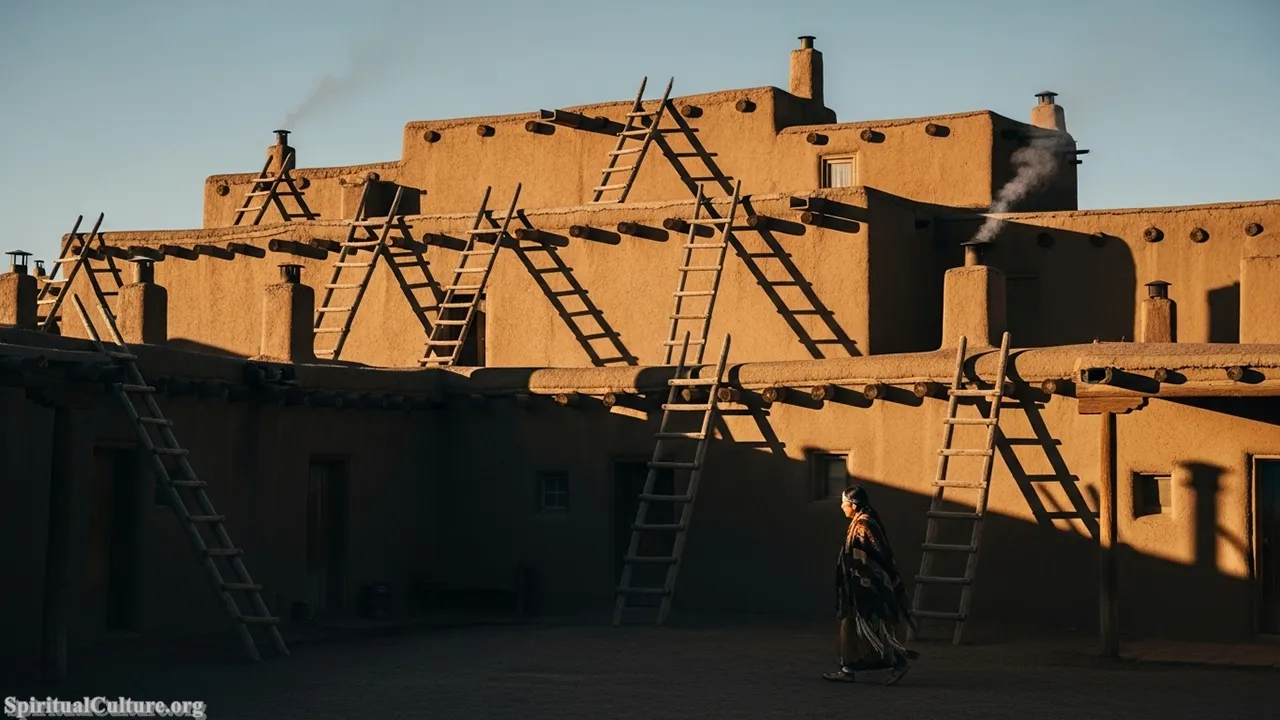
The preeminent ranking of Taos Pueblo is due to its status as a World Heritage Site that is not a ruin, but a sacred, living center of tradition. Its spiritual impact is in its permanence; it embodies the spiritual principle of continuity (hozho in related traditions). The community’s unyielding dedication to preserving its traditional practices, language, and the integrity of its physical form—eschewing modern amenities like indoor plumbing and electricity in the historical core—makes it an unparalleled cultural anchor.
Taos Pueblo provides the ultimate reflection on the power of cultural sovereignty and resistance. Its existence is a moral lesson in honoring the past by actively living it in the present. Its survival across millennia, including pivotal roles in the Pueblo Revolt of 1680 and the decades-long struggle to reclaim the sacred Blue Lake (successful in 1970), makes it a global symbol of Indigenous spiritual and political fortitude.
Cultural/Spiritual Highlights:
- Continuously inhabited for over 1,000 years, a powerful symbol of Indigenous resilience.
- UNESCO World Heritage Site (1992) and National Historic Landmark.
- The community fought for and successfully reclaimed the highly sacred Blue Lake in 1970.
- Buildings are traditionally constructed from adobe and represent a living, evolving heritage.
Top 1. Cahokia Mounds State Historic Site (Illinois)
Cahokia, near modern-day St. Louis, was the largest pre-Columbian city north of Mexico, the epicenter of the Mississippian culture. Flourishing between 1050 and 1350 CE, it once housed an estimated 10,000 to 20,000 residents, a population size comparable to many contemporary European cities. The site is dominated by the colossal Monks Mound, a four-terraced earthwork larger at its base than the Great Pyramid of Giza, representing a pinnacle of early urban Indigenous organization.
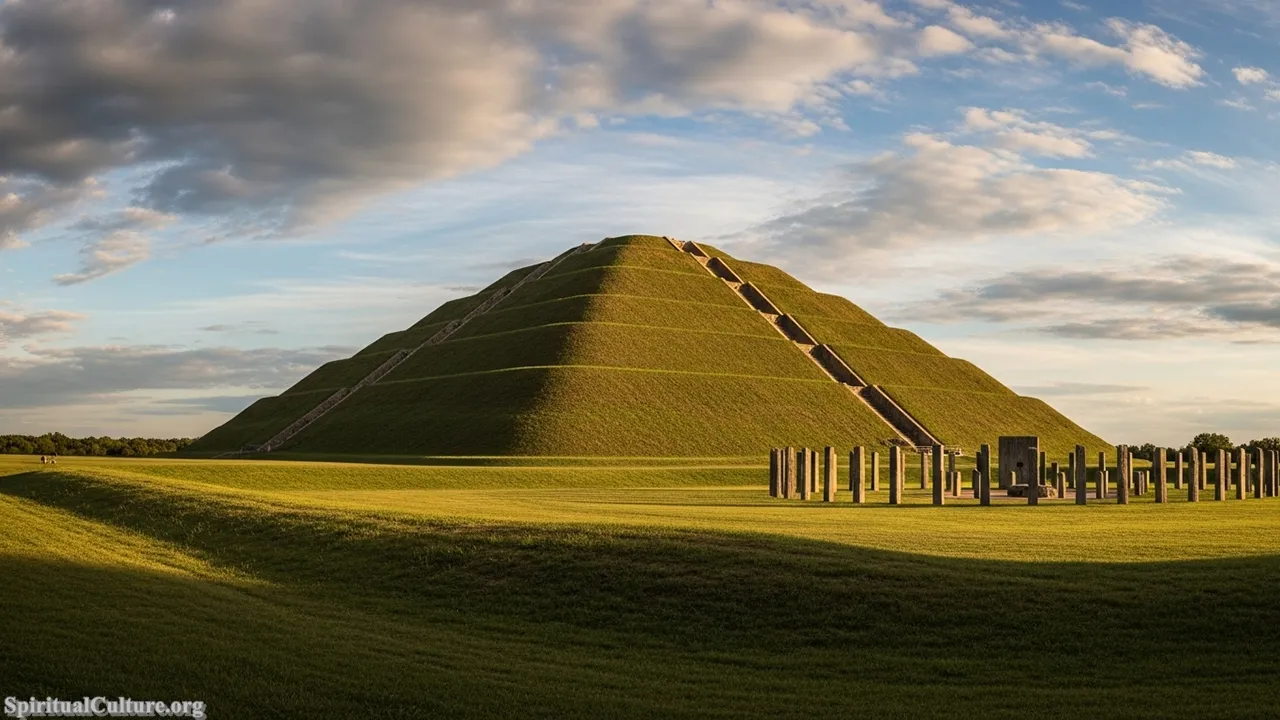
Cahokia Mounds earns the top ranking for its unparalleled scale and demonstration of a complex, centralized Mississippian society dedicated to sacred architecture. Its spiritual impact is tied to its role as a cosmological focal point; the entire site was laid out with astronomical precision, including the reconstructed solar calendar known as “Woodhenge.” This immense, engineered landscape served as a spiritual pilgrimage center, drawing people from vast distances and reflecting a shared, powerful belief system rooted in the cycles of the natural and celestial worlds.
The silent, massive presence of Monks Mound offers a profound reflection on the heights of ancient North American civilization. It challenges preconceived notions of North American prehistory and affirms the genius of Indigenous spiritual engineering. The preservation of this World Heritage Site is crucial, for it stands as the most compelling evidence of a monumental, urban, and spiritually sophisticated Native American society that influenced much of the continent’s cultural development.
Cultural/Spiritual Highlights:
- The largest and most complex pre-Columbian archaeological site north of Mexico.
- Home to Monks Mound, the largest prehistoric earthen structure in the Americas.
- UNESCO World Heritage Site since 1982.
- Features Woodhenge, a reconstructed solar calendar used for ceremonial timing and celestial alignment.
Conclusion
The sites ranked here—from the monumental urbanism of Cahokia to the living adobe of Taos Pueblo—are far more than historical relics; they are the enduring spiritual anchors of the continent. They demonstrate that Indigenous cultures developed sophisticated societies, built profound connections to the cosmos, and exhibited a resilient spiritual dedication to their homelands. As of November 2025, the preservation of these places is a celebrated act of global heritage protection and a crucial assertion of cultural sovereignty.
At Spiritual Culture, we celebrate these sites for the wisdom they offer: that the deepest meaning of human civilization is often found in the ability to integrate community, ceremony, and the careful stewardship of the sacred land. Their continued existence provides an invaluable lesson in the power of spiritual conviction to shape, sustain, and define a people across millennia. May their stories continue to be told with the reverence and depth they deserve.
